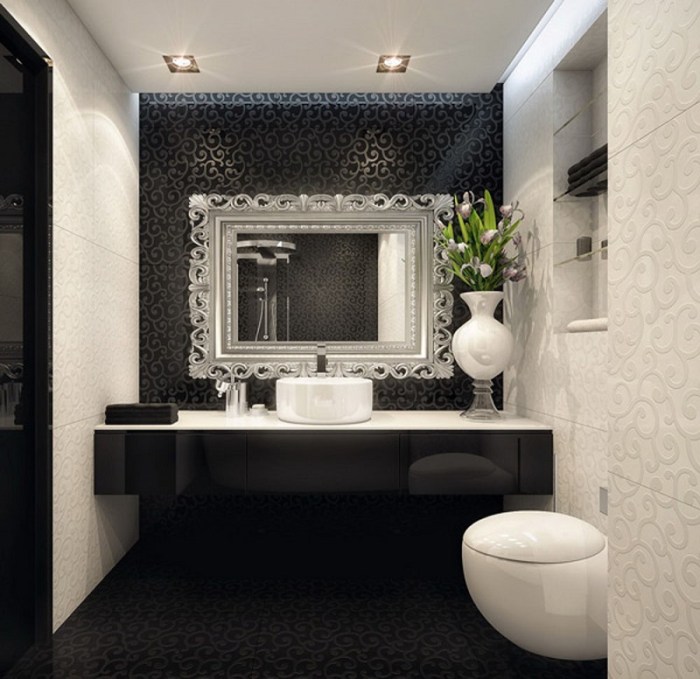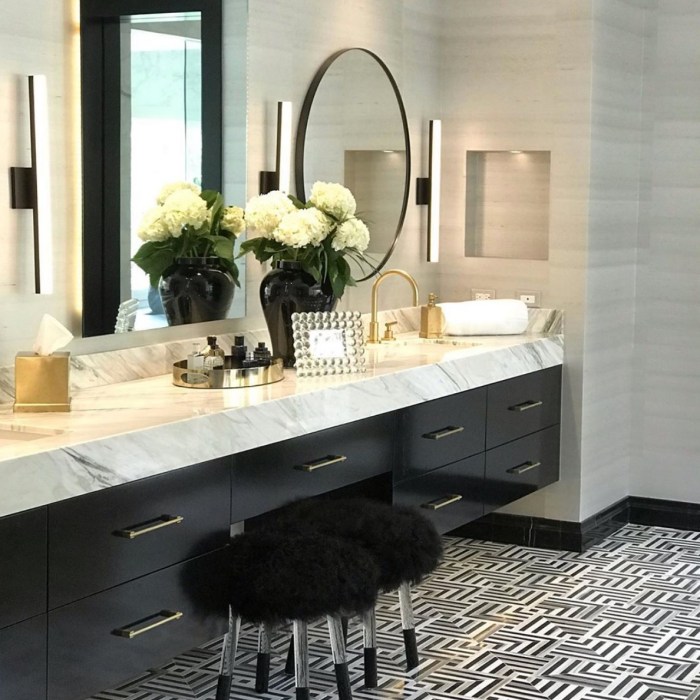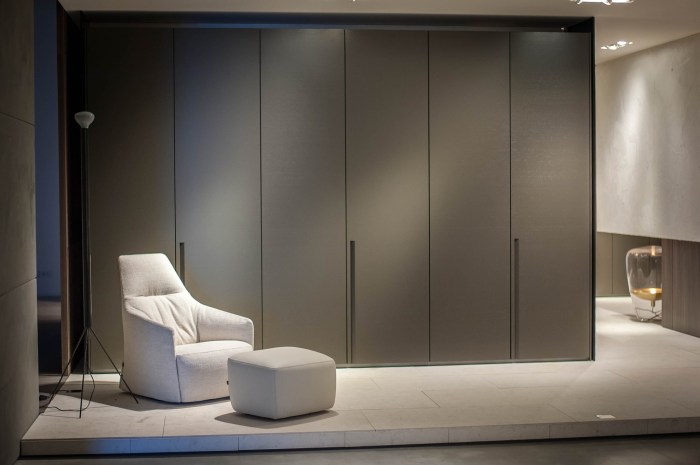Black and White Bathroom Decor Ideas
Modern Black and White Bathroom Design Trends
Black and white bathroom decor ideas – Yo, Surabaya peeps! Black and white bathrooms? So last century, right? Wrong! This classic combo is getting a serious upgrade, and it’s way more stylish than you think. We’re talking modern, sleek, and totally Instagrammable. Let’s dive into the freshest trends.
Black and white bathroom designs offer endless possibilities for creating a sophisticated and personalized space. The timeless contrast allows for both bold statements and subtle elegance, adapting to various styles and preferences. The key is to find the right balance and incorporate modern elements to avoid a dated look.
Current Black and White Bathroom Design Trends
Three major trends are shaping the modern black and white bathroom aesthetic. These trends showcase the versatility of this classic color scheme and how it can be adapted to different design styles.
- Bold Geometric Accents: Think sharp lines, unexpected shapes, and striking patterns. We’re not talking your grandma’s floral wallpaper. This is about creating a visually dynamic space using strong geometric shapes in black and white tiles, or even through carefully placed accessories.
- Textured Surfaces and Materials: Moving beyond plain tiles, designers are embracing a variety of textures to add depth and visual interest. Think matte black fixtures against glossy white tiles, or the contrast of rough-hewn stone with smooth, polished surfaces.
- Incorporation of Natural Elements: The stark contrast of black and white is softened and warmed by the introduction of natural materials like wood and stone. This creates a more inviting and less sterile atmosphere, balancing the clean lines with organic textures.
Geometric Patterns and Textures in Modern Black and White Bathrooms, Black and white bathroom decor ideas
Geometric patterns are no longer just a simple addition; they’re the statement piece in many modern black and white bathrooms. Think chevron tiles, hexagonal mosaics, or even a bold black and white graphic wallpaper featuring intricate geometric designs. These patterns can be used on floors, walls, or even as accents on vanities or shower surrounds. Pairing these with textured elements like a concrete countertop or a woven rug adds a layer of complexity and visual richness.
The interplay between sharp lines and varied textures prevents the space from feeling flat or monotonous. For example, a bathroom with a bold chevron tile floor could be complemented by a matte black vanity with a wood grain texture, creating a striking yet balanced design.
Incorporating Natural Elements into Black and White Bathroom Schemes
To avoid a cold, clinical feel, designers are cleverly incorporating natural elements. This isn’t about throwing in a random potted plant; it’s about thoughtful integration. Think of a dark wood vanity with sleek black hardware, contrasting against crisp white walls and a stone countertop. The warmth of the wood balances the coolness of the black and white, creating a more inviting and relaxing atmosphere.
Similarly, a stone shower surround adds a touch of natural texture and visual interest. The use of natural materials can also extend to accessories such as woven baskets for storage or wooden shelving units. This subtle infusion of nature softens the hard lines of the black and white palette, resulting in a sophisticated yet approachable design.
Black and White Bathroom Tile Ideas
Choosing the right tiles can totally transform your bathroom vibe. Black and white tiles offer a classic, versatile look that’s super adaptable to different styles, from minimalist modern to a retro-chic feel. Getting the right pattern and layout is key to nailing the look you want.
Black and White Tile Design Ideas
The combination of black and white tiles allows for endless design possibilities. Here are five different tile design ideas to inspire your bathroom renovation:
| Design | Description |
|---|---|
| Checkerboard | A classic and timeless pattern, the checkerboard design uses equal-sized black and white square tiles arranged in an alternating pattern. This creates a bold and graphic look, perfect for a modern or vintage-inspired bathroom. Consider using larger tiles for a more spacious feel or smaller tiles for a busier, more detailed look. |
| Subway Tile with Accent Band | Traditional subway tiles (rectangular) in white are a staple, but adding a band of black subway tiles horizontally or vertically creates a striking accent. This is a simple yet effective way to add visual interest without overwhelming the space. A thin black grout line will further emphasize the contrast. |
| Hexagon Mosaic | Black and white hexagon tiles, arranged in a repeating pattern or randomly, create a sophisticated and textured look. The hexagonal shape adds a unique geometric element that breaks up the monotony of square or rectangular tiles. Consider varying the size of the hexagons for a more dynamic design. |
| Geometric Pattern | Use a combination of square and rectangular tiles in black and white to create intricate geometric patterns. This could involve creating stripes, triangles, or more complex designs. This option is perfect for those who want a more artistic and unique bathroom design. |
| Black and White Marble Effect | Large format tiles mimicking the look of black and white marble offer a luxurious and elegant touch. The veining of the marble creates natural visual interest, minimizing the need for complex patterns. This design works particularly well in larger bathrooms. |
Effect of Tile Size and Shape
The size and shape of your tiles significantly impact the overall feel of your bathroom. Larger tiles, such as large format porcelain slabs, create a sense of spaciousness and modernity, especially in smaller bathrooms. Smaller tiles, such as mosaics, add texture and visual interest, but can make a room feel smaller if overused. Rectangular tiles (like subway tiles) offer a classic, clean look, while hexagonal or other geometric shapes add a more contemporary and artistic feel.
Consider the proportions of your bathroom when choosing tile size and shape – larger tiles in a small bathroom might feel overwhelming, while small tiles in a large bathroom might feel too busy.
Creating a Focal Point with Black and White Tiles
A visually appealing focal point can be created using contrasting black and white tiles. One effective method is to create a feature wall behind the vanity or bathtub. This wall could be tiled in a bold pattern, such as a large-scale checkerboard or a geometric design, while the rest of the bathroom uses a simpler, more understated tile.
Another option is to use a contrasting border tile to frame a section of the wall, highlighting a specific area. Alternatively, a black and white mosaic could be used to create a stunning backsplash around a freestanding tub. The key is to use the contrast and pattern strategically to draw the eye and create a sense of visual interest.
Creating a Visual Contrast with Black and White

Yo, peeps! Black and white bathrooms? So last century, right? Wrong! With a little savvy styling, a monochrome bathroom can be seriously chic and way more interesting than you think. The key is mastering visual contrast – think depth, drama, and a whole lotta style.This isn’t about just slapping black and white together and calling it a day.
It’s about using different shades, textures, and strategic placement to create a space that pops. We’re talking about making your bathroom the envy of all your Surabaya crew.
Shades of Black and White
Using only stark black and white can feel, like, totally flat. To avoid that, incorporate different shades and tones. Think charcoal grey against crisp white, or creamy off-white paired with a deep, almost-black slate. Imagine a bathroom with matte black fixtures against a backdrop of glossy white subway tiles – the contrast in sheen adds another layer of visual interest.
Or picture a shower enclosure with a textured, dark grey stone against a wall of bright white tiles. The variation in shades creates visual depth and prevents the space from feeling one-dimensional.
Texture’s Role in Contrast
Texture is your secret weapon, guys. It’s the element that truly elevates a black and white bathroom from basic to
bangin’*. A smooth, polished black countertop paired with a roughly textured whitewashed brick wall instantly creates a captivating contrast. Think about incorporating different materials
a plush, white bathmat against a cool, smooth black tile floor, or a woven basket for towels next to a sleek, mirrored cabinet. The interplay of textures adds another dimension, making the space feel dynamic and luxurious. A fluffy white rug placed on a cool, dark grey tile floor, for example, creates a textural contrast that is both inviting and stylish.
Black and White Bathroom for Small Spaces

Yo, Surabaya peeps! Thinking of a black and white bathroom but worried about space? Don’t sweat it! Even a tiny bathroom can be a stylish oasis with the right design choices. This isn’t about cramming stuff in; it’s about maximizing what you’ve got with clever tricks and a cool, clean aesthetic.Small bathrooms can feel cramped, but with some smart planning, you can create a space that feels surprisingly spacious and luxurious.
Think of it as a minimalist masterpiece, where every element serves a purpose and contributes to the overall feeling of openness.
Design Strategies for Maximizing Space in a Small Black and White Bathroom
Using a monochromatic palette like black and white is already a smart move for small spaces. The lack of color variation creates a sense of visual unity, making the room feel less cluttered and more expansive. Here are some key strategies to amplify that effect:
- Embrace Minimalism: Ditch unnecessary clutter. Keep countertops clear, and opt for floating shelves or wall-mounted cabinets to maximize floor space. Think sleek, simple designs instead of bulky storage solutions.
- Verticality is Your Friend: Use tall, narrow cabinets and mirrors to draw the eye upwards, creating an illusion of height. A tall, slender mirror, for example, will visually extend the wall and make the space feel taller.
- Light and Bright Color Scheme: While we’re working with black and white, prioritize white or very light gray for the walls and larger surfaces. This reflects light, making the space appear larger and brighter. Use black strategically as an accent – on smaller elements like a frame, towel rack, or shower trim.
Utilizing Mirrors and Lighting to Maximize Space
Mirrors are your secret weapon in a small bathroom. They not only add a touch of glam but also visually double the space, making it feel far more expansive. Strategically placed lighting enhances this effect.Mirrors should be positioned to reflect light sources, such as windows or strategically placed light fixtures. A large mirror on the wall opposite the main light source will reflect light across the room, creating a brighter, more open feeling.
Avoid placing mirrors directly opposite each other, as this can create a dizzying effect. Consider a large, framed mirror above the vanity or a smaller, stylish mirror on a side wall.Good lighting is crucial. Layer your lighting with a combination of ambient, task, and accent lighting. Ambient lighting provides overall illumination, while task lighting (like a vanity light) illuminates specific areas.
Accent lighting, such as LED strip lights under cabinets, adds subtle highlights and a modern touch. Avoid harsh, overhead lighting; instead, opt for softer, diffused light sources to create a relaxing atmosphere.
Ideal Layout and Fixture Choices for a Small Black and White Bathroom
The layout and fixtures you choose are vital for maximizing space and functionality in a small black and white bathroom.A well-planned layout ensures efficient use of space. Consider a corner shower to save floor space. A wall-mounted toilet and a compact vanity with a vessel sink are also excellent space-saving options. Choose streamlined fixtures with clean lines to avoid a cluttered look.
A sleek, modern vanity with integrated storage is perfect for keeping things tidy. The smaller the fixtures, the better the flow of the bathroom. Think about integrated storage within the vanity and the use of vertical space with shelving.
Budget-Friendly Black and White Bathroom Decor

Transforming your bathroom into a stylish black and white haven doesn’t require emptying your wallet. With a little creativity and smart shopping, you can achieve a high-end look without breaking the bank. This guide explores cost-effective ways to create a chic and modern black and white bathroom that reflects your personal style.
Affordable Materials and Fixtures
Choosing the right materials and fixtures is crucial for achieving a luxurious look without the luxury price tag. Focusing on durable, versatile options that can withstand bathroom humidity is key.
- Wall Tiles: Instead of expensive marble, consider budget-friendly alternatives like subway tiles in black and white. These classic tiles offer a timeless appeal and are widely available at affordable prices. A simple, staggered pattern adds visual interest without the need for complex installations. Imagine a clean white subway tile backdrop with a black grout line, creating a striking and modern aesthetic.
- Floor Tiles: Large-format porcelain tiles mimic the look of expensive stone at a fraction of the cost. Look for matte finishes to avoid slippery surfaces and choose a black and white pattern that complements your wall tiles. For instance, large black square tiles interspersed with smaller white ones would provide a sophisticated geometric pattern. This approach provides a sleek and contemporary feel.
- Vanity and Fixtures: A simple, white vanity with black hardware offers a classic, elegant look. You can find affordable vanities at home improvement stores and easily update them with new hardware for a personalized touch. Consider a matte black faucet and handles for a modern contrast against the white vanity. The contrast between the matte black and bright white creates a striking focal point in the room.
DIY Projects for Added Personality
DIY projects offer a fantastic way to inject personality into your black and white bathroom while saving money. These simple projects can make a big impact without requiring advanced skills.
- Framed Prints: Create a gallery wall with black and white prints of your favorite artwork, photos, or even botanical illustrations. Use inexpensive frames from thrift stores or dollar stores, painting them black or white to maintain a cohesive look. A curated selection of black and white prints can add a personalized touch to your bathroom walls, transforming it from functional to expressive.
- Stenciling: Add a unique pattern to your walls or vanity using stencils and black or white paint. Geometric patterns, floral designs, or even simple stripes can create a visually interesting focal point. A simple geometric pattern stenciled onto a white wall adds an element of surprise and visual texture without the need for complex designs.
- Repurposed Items: Transform old jars or containers into stylish storage solutions. Paint them black or white and use them to store cotton balls, toiletries, or other bathroom essentials. This adds a touch of personal style while also providing functional storage solutions that are both visually appealing and practical.
Answers to Common Questions: Black And White Bathroom Decor Ideas
Can I use black and white in a small bathroom?
Absolutely! Strategic use of mirrors, light colors, and clever layouts can make a small black and white bathroom feel spacious and airy.
What are some affordable black and white bathroom options?
Consider budget-friendly tile options, DIY projects like painting accent walls, and repurposing existing fixtures.
How do I avoid a stark or cold feel in a black and white bathroom?
Incorporate warm lighting, textured elements like wood or stone, and plants to soften the contrast and add warmth.
What are some unique accessory ideas for a black and white bathroom?
Consider interesting mirrors, unique lighting fixtures, patterned rugs, and decorative storage containers.

















